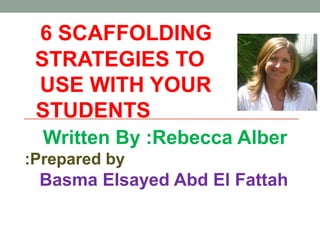
6 scaffolding strategies to use with your students
- 1. 6 SCAFFOLDING STRATEGIES TO USE WITH YOUR STUDENTS Written By :Rebecca Alber Prepared by: Basma Elsayed Abd El Fattah
- 2. Objectives What’s the opposite of scaffolding a lesson? What do we mean by scaffolding? What are the six scaffolding strategies teachers can use at classrooms?
- 3. The opposite of scaffolding is • Asking students to do something like : • Read a nine- page science article OR • Write a detailed essay on the topic it explores and turn it by Wednesday
- 4. • Let’s agree that scaffolding a lesson and differentiating instruction are two different things. • Scaffolding is the type of assistance offered by a teacher or peer to support learning .
- 5. What is scaffolding? •Scaffolding is breaking up the learning into chunks and then providing a tool, or structure, with each chunk.
- 7. •When scaffolding reading, for example, you might preview the text and discuss key vocabulary, or chunk the text and read and discuss as you go
- 8. What about differentiating instruction? • With differentiating, 1. you may give a child an entirely different piece of text to read. 2. you might shorten the text or alter it. 3. You may modify the writing assignment that follows.
- 9. • In the process of scaffolding, The teacher helps the student master a task or concept that the student is initially unable to grasp independently. The teacher offers assistance with only those skills that are beyond the student’s capability.
- 10. •In order to meet students where they are, you have to know the individual and collective zone of proximal development (ZPD) of your learners
- 11. The zone of proximal development (ZPDThe zone of proximal development (ZPD)) the distance between the actual developmental level as determined by independent problem solving and the level of potential development as determined through problem solving under adult guidance, or in collaboration with more capable peers“ (Vygotsky, 1978, p86).
- 12. As education researcher , Eileen Raymond states that: •“The ZPD is the distance between what children can do by themselves and the next learning that they can be helped to achieve with competent assistance.”
- 15. 6scaffolding strategies Show and Tell Tap into prior knowledge Give time to talk Pre-teaching vocabulary Use visual aids Pause Ask questions,Pause,Review
- 16. Show and Tell •Modeling for students is a cornerstone of scaffolding in my experience. • Have you ever interrupted someone with "just show me!" while they were in the middle of explaining to you how to do something?
- 18. A. A-fish bowl activity • where a small group in the center are circled by the class as the group in the middle, or fishbowl, engage in an activity, modeling how it's done for the larger group.
- 19. • which will allow you to model your thought process for developing critical thinking as you: • read a text, • solve a problem, • or design a project
- 20. Always show students the outcome or product before they do it . If a teacher assigns a persuasive essay or inquiry-based science project, a model should be presented side-by-side with a criteria chart or rubric. You can guide students through each step of the process, model in-hand of the finished product
- 21. 2. Tap into Prior Knowledge • Ask students to share their own experiences, hunches, and ideas about the content or concept of study and have them relate and connect it to their own lives
- 22. Give time to TALK • All learners need time to process new ideas and information. They also need time to verbally make sense of and articulate their learning with the community of learners who are • also engaged in the same • experience and journey HOW?
- 23. think-pair-share
- 24. Turn-and-Talk •Look at your partner •Listen to your partner • Be ready to speak when it’s your turn • Speak so that only your partner can hear you. •Turn and face the front, when you and your partner are finished sharing.
- 25. 4.Pre-Teach Vocabulary Use analogies metaphors introduce the words to kids in photos, and in context Dictionaries invite students to create a symbol or drawing for each word Pictures Charts
- 26. 5.Use Visual Aids Graphic organizers, pictures, and charts
- 29. 6.Pause, Ask Questions, Pause, Review • To check for understanding while students read a chunk of difficult text or learn a new concept or content. Here's how this strategy works: new idea from discussion or the reading is shared, then pause (providing think time), then ask a strategic question, pausing again.
- 30. • By strategic, you need to design them ahead of time, make sure they are specific, guiding and open-ended questions. (Great questions fail without giving think time for responses so hold out during that Uncomfortable Silence.).
- 31. • keep kids engaged as active listeners by calling on someone to "give the gist" of what was just discussed / discovered / questioned. • If the class seems stuck by the questions, provide an opportunity for students to discuss it with a neighbor
- 32. Trying Something New • . Scaffolding a lesson may, in fact, take longer to teach, but the end product is of far greater quality and the experience much more rewarding for all involved.
